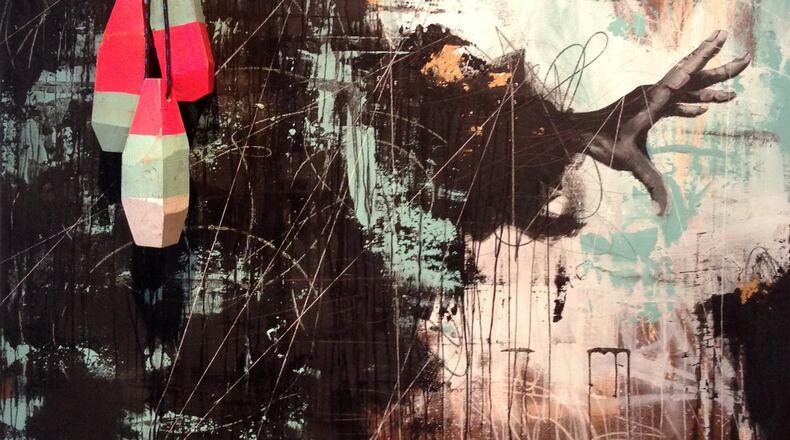Though the odds are long, every few years, one Georgia artist is guaranteed to hit the financial jackpot.
Since 2010 an anonymous donor has awarded four Georgia artists a staggering windfall: the $50,000 Hudgens Prize, one of the largest art awards to individual artists in the nation. The Hudgens Prize also includes a solo exhibition at Duluth’s Hudgens Center for Art & Learning for the winner. The award is a profound acknowledgement of the homegrown talent in the state and a chance for an artist to make serious inroads in their creative growth.
This year's four Hudgens Prize finalists, chosen from among 192 applicants, will exhibit their work at the Hudgens Center beginning Aug. 10. Viewers will have the chance to see how these very different artists use dance, painting, installation and ceramics to investigate issues that encompass race, personal history and human consciousness.
This year’s finalists include dancer Benae Beamon, who uses tap dancing and movement as vehicles to look at race, labor, gender and sexuality; painter Michi Meko, whose moody mixed media works are informed by Southern and personal history; painter Paul Stephen Benjamin, whose critically heralded artwork investigates the color black and its meaning; and Darien Arikoski-Johnson, who uses an innovative approach to ceramics to explore digital media’s influence on our perception of reality.
The winner will be announced Oct. 5 at the Hudgens Center.
The finalists and the winner are chosen by a panel of experts. This year they are Glenn Adamson, senior scholar at the Yale Center for British Art; Anne Ellegood, senior curator at Los Angeles’s Hammer Museum; and Amber Esseiva, assistant curator at the Institute for Contemporary Art at Virginia Commonwealth University. The jurors will travel to Georgia for a last round of studio visits before picking the winner.
Though their work is very different, all four artists “draw on deep history yet also are making work that feels relevant and fresh for right now,” notes juror Adamson, who says he found a high level of sophistication in all of the artists’ work.
The aim of the Hudgens Prize is to be transformational in an artist’s career.
“The prize has provided the previous recipients the opportunity to spend a significant amount of time and resources in the exploration and development of their work, without the typical financial concerns,” says Hudgens Center Executive Director Ife Williams. “This alone is transformative as it provides the space to either complete work that has been halted due to financial unknowns or to pursue new pathways because there is a small cushion to absorb early failures and redirections.”
Previous winners attest to the impact the award has made on their careers. Gyun Hur, the Hudgens Prize's first winner, was fresh out of graduate school at the Savannah College of Art and Design and had been patching together a living working at her parents' dry cleaners and tutoring immigrant students when she found out she had won the inaugural $50,000 prize.
“It gave visibility to my work and my story. It gave me support and courage to keep moving forward with projects I felt drawn to do,” says Hur.
Pam Longobardi won the second Hudgens Prize in 2013. "With the prize money, I hired an assistant, Susan Knippenberg, to work with me in the studio, allowing me to take on more ambitious projects, as well as accompany me on international field research trips and exhibition installations," she says. "I will forever be grateful to the gift that is the Hudgens Prize."
Current Hudgens Prize finalist Beamon says that for her, winning the award would be a powerful affirmation of where she is as an artist. “To win this prize would mean a unique opportunity for me to dedicate myself entirely to the creation of new artistic work and my own artistic development.”
An added benefit of the prize is it entices artists to stay and make work in Georgia.
“The value in the prize is in its investment in Georgia artists,” says juror Esseiva. “It potentially allows for an artist to be able to continue their practice in the region, which is needed in a time when many artists feel pressure to move to cities like New York or Los Angeles.”
The Hudgens Prize is fundamental, says Longobardi, for showing the presence and importance of arts patronage in the state. “It creates an atmosphere of elevating the arts significantly as an important and essential endeavour worthy of high recognition in a region of the country not previously known for its support of visual art culture.”
EVENT PREVIEW
Hudgens Prize Finalist Exhibition. Opening reception 2-4 p.m. Aug. 10. Show continues through Oct. 26. Artist talks: Darien Arikoski-Johnson and Paul Stephen Benjamin, 2-4 p.m. Aug. 24; Michi Meko and Benae Beamon, 2-4 p.m. Sept. 14. All events free. Hudgens Center for Art & Learning, 6400 Sugarloaf Parkway, Building 300, Duluth. 770.623.6002, www.thehudgens.org/exhibitions
2019 Hudgens pARTy: Club Tropicana. Hudgens Prize winner announcement and fundraiser. 7-11:30 p.m. Oct. 5. $100 and up. Hudgens Center. www.eventbrite.com
About the Author
Keep Reading
The Latest
Featured



